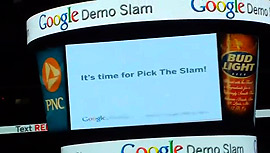InStadium Uses Jumbo Screens As Ad Network
- by Karl Greenberg , October 24, 2012
 A big roster of major league brands are trying
something different with sports: using the Jumbo HD screens at sports venues nationwide as a new major media network for advertising to attendees.
A big roster of major league brands are trying
something different with sports: using the Jumbo HD screens at sports venues nationwide as a new major media network for advertising to attendees.
Dave Kissel, president, CEO of sports venue network InStadium, which brokers in-stadium giant screen ad deals for top-tier brands like Chevrolet, McDonald's, and Disney, says the Chicago-based firm's opportunity came when a revenue crunch hit teams.
"The problem was that this big-screen inventory was once reserved only for team sponsors," he explains. "What happened? Teams found themselves in labor markets that got incredibly expensive, while players also got real expensive." He adds that teams hit the revenue wall in terms of earnings garnered from sponsor-only ads and concessions. "Teams found themselves in a situation where they needed revenue, but didn't have that access to a big group of advertisers."
advertisement
advertisement
While the company brokers vertical and horizontal (across a range of teams) deals for advertisers, its partnerships are with some 480 NBA, NFL, MLB and NCAA teams; they control ad rights in the buildings where they play. With college teams, it's marketing agencies like IMG College, Learfield Sports and Nelligan Sports who handle their venue media deals.
InStadium, notes Kessel, essentially packages three in-venue assets: a ten-second PA announcement directing fans to the screen, 30-second high-def video, and the digital crowd rings -- those rich-media strips that encircle the venue -- whose creative aligns with what's on the screen. Then, depending on the advertiser, there can be such engagement elements like texting sweepstakes and competitions.
Kessel says most of the company's ad deals tend to be contemporaneous with the TV upfront. InStadium reports that per Nielsen, its network reaches 128 million adults 18+ annually. "We offer a way for brands to enhance and accompany their TV buys," he says, adding that InStadium's network is followed by planning systems and measured by Nielsen, among network measurement firms. He says the difference versus TV is that the live audience comprises light-TV viewers who are unlikely to be receptors of traditional ads on TV.
Is there a barrier? Yes, stadiums that have tied up major brand partnerships will not advertise directly competitive brands.
From the advertiser's perspective, the ads have to be entertaining; the more contextually relevant the better. "When you go through that turnstile, the next three hours are going to be fun," says Kissel. "We particularly do well with entertainment brands because the audience likes it."


